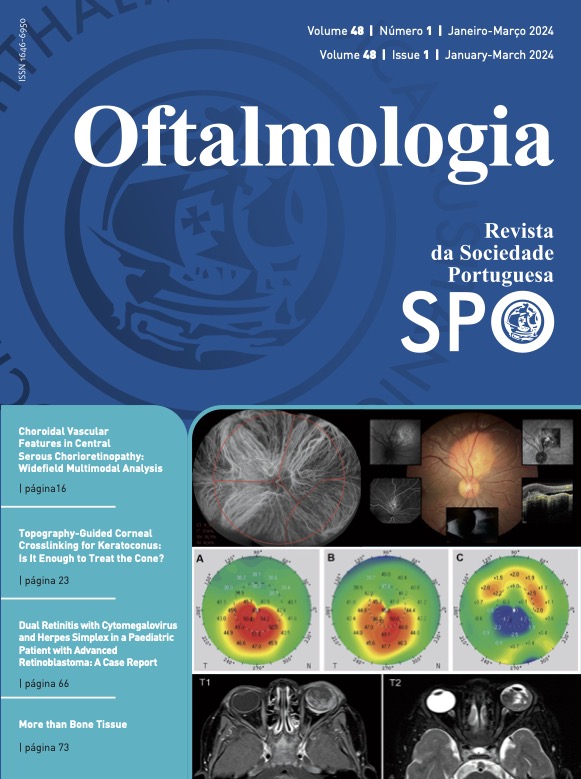O Papel da Biomecânica Corneana como Preditor de Membranas Neovasculares Coroideias em Olhos Míopes
DOI:
https://doi.org/10.48560/rspo.28312Palavras-chave:
Cornea, Fator de Crescimento do Endotélio Vascular, Fenómenos Biomecânicos, Lâmina Basilar da Corioide, Miopia, Neovascularização de CoroideResumo
INTRODUÇÃO: A maculopatia miópica na forma de neovascularização coroideia (mCNV) pode apresentar um impacto significativo na função visual, frequentemente em pacientes jovens ativos. O presente trabalho teve como objetivo descrever a biomecânica corneana em olhos míopes com histórico de mCNV tratados com anti-fator de crescimento endotelial vascular (VEGF) intravítreo e compará-la com os olhos contralaterais. Os objetivos secundários foram analisar subgrupos dentro do grupo de olhos com mCNV e abordar preditores de doença e resposta ao tratamento.MÉTODOS: Estudo observacional unicêntrico, transversal, caso-controlo, incluindo indivíduos acima de 18 anos com miopia e história de mCNV unilateral tratada com anti-VEGF intravítreo, no Centro Hospitalar e Universitário do Porto. As informações relacionadas com o tratamento foram adquiridas através dos processos clínicos dos pacientes. Foi realizado um questionário incluindo dados pessoais demográficos, biométricos e relacionados ao estilo de vida. A avaliação biomecânica obteve-se através da tecnologia de câmara de Scheimpflug, por meio do Corvis ST® (OCULUS). Os parâmetros biométricos oculares foram adquiridos pelo biómetro Anterion® (Heidelberg). As avaliações anatómicas maculares foram realizadas por meio da plataforma OCT Spectralis® (Heidelberg).
RESULTADOS: Foram incluídos 64 olhos de 32 pacientes, 87,5% do sexo feminino, com média de idade de 62,5+-13,3 anos. Foi encontrada uma tendência para um menor HC-time em olhos com mCNV. Olhos com buracos na membrana de Bruch macular (MBMH) apresentaram valores mais elevados de WEM time max e TBI e pertenciam a indivíduos com mais atividade física e maior exposição à luz UV. Vários parâmetros biomecânicos correlacionaram-se com os hábitos de vida. O diâmetro da membrana foi moderada a fortemente correlacionado com um comportamento biomecânico menos rígido, enquanto o número de injeções de anti-VEGF intravítreo se associou sem um padrão consistente. Um modelo biomecânico puro foi construído para prever a presença de MBMH, incluindo o WEM time max e TBI, com AUROC de 0,808 e sem influência de AL ou da pressão ocular.
CONCLUSÃO: Segundo conhecimento dos autores, este é o primeiro estudo avaliando a biomecânica ocular in vivo em olhos com mCNV. A biomecânica mostrou resultados promissores como preditor de mCNV, mais especificamente de MBMH. Parece estar associado a fatores de estilo de vida e estudos futuros devem ser realizados para confirmar nossos achados, abrindo caminho para a introdução de um paradigma dinâmico na avaliação de risco de mCNV de olhos míopes.
Downloads
Referências
Ruiz-Medrano J, Montero JA, Flores-Moreno I, Arias L, García-Layana A, Ruiz-Moreno JM. Myopic maculopathy: Current status and proposal for a new classification and grading system (ATN). Prog Retin Eye Res. 2019;69:80-115. doi: 10.1016/j.preteyeres.2018.10.005.
Holden BA, Fricke TR, Wilson DA, Jong M, Naidoo KS, Sankaridurg P, et al. Global prevalence of myopia and high myopia and temporal trends from 2000 through 2050. Ophthalmology. 2016;123:1036-42. doi: 10.1016/j.ophtha.2016.01.006.
Xu L, Cui T, Yang H, Hu A, Ma K, Zheng Y, et al. Prevalence of visual impairment among adults in China: the Beijing Eye Study. Am J Ophthalmol. 2006;141:591-3. doi: 10.1016/j.ajo.2005.10.018.
Wong YL, Sabanayagam C, Ding Y, Wong CW, Yeo AC, Cheung YB, et al. Prevalence, risk factors, and impact of myopic macular degeneration on visual impairment and functioning among adults in Singapore. Invest Ophthalmol Vis Sci. 2018;59:4603-13. doi: 10.1167/iovs.18-24032.
Iwase A, Araie M, Tomidokoro A, Yamamoto T, Shimizu H, Kitazawa Y. Prevalence and causes of low vision and blindness in a Japanese adult population: the Tajimi Study. Ophthalmology. 2006;113:1354-62. doi: 10.1016/j.ophtha.2006.04.022.
Klaver CC, Wolfs RC, Vingerling JR, Hofman A, de Jong PT. Age-specific prevalence and causes of blindness and visual impairment in an older population: the Rotterdam Study. Arch Ophthalmol. 1998;116:653-8. doi: 10.1001/archopht.116.5.653.
Cedrone C, Nucci C, Scuderi G, Ricci F, Cerulli A, Culasso F. Prevalence of blindness and low vision in an Italian population: a comparison with other European studies. Eye. 2006;20:661-7. doi: 10.1038/sj.eye.6701934.
Cotter SA, Varma R, Ying-Lai M, Azen SP, Klein R. Causes of low vision and blindness in adult Latinos: the Los Angeles Latino Eye Study. Ophthalmology. 2006;113:1574-82. doi: 10.1016/j.ophtha.2006.05.002.
Cheung CMG, Arnold JJ, Holz FG, Park KH, Lai TYY, Larsen M, et al. Myopic Choroidal Neovascularization: Review, Guidance, and Consensus Statement on Management. Ophthalmology. 2017;124:1690-711. doi: 10.1016/j.ophtha.2017.04.028.
Fang Y, Yokoi T, Nagaoka N, Shinohara K, Onishi Y, Ishida T, et al. Progression of Myopic Maculopathy during 18-Year Follow-up. Ophthalmology. 2018;125:863-77. doi: 10.1016/j.ophtha.2017.12.005.
Ambrósio Jr R, Ramos I, Luz A, Faria FC, Steinmueller A, Krug M, Belin MW, et al. Avaliação Dinâmica com fotografia de Scheimpflug de alta velocidade para avaliar as propriedades biomecânicas da córnea. Rev Bras Oftalmol. 2013;72:99-102.
Koprowski R, Ambrósio R, Jr., Reisdorf S. Scheimpflug camera in the quantitative assessment of reproducibility of high-speed corneal deformation during intraocular pressure measurement. J Biophotonics. 2015;8:968-78. doi: 10.1002/jbio.201400137.
Baptista PM, Ambrosio R, Oliveira L, Meneres P, Beirao JM. Corneal Biomechanical Assessment with Ultra-High-Speed Scheimpflug Imaging During Non-Contact Tonometry: A Prospective Review. Clin Ophthalmol. 2021;15:1409-23. doi: 10.2147/opth.S301179.
Salomão MQ, Hofling-Lima AL, Gomes Esporcatte LP, Lopes B, Vinciguerra R, Vinciguerra P, et al. The Role of Corneal Biomechanics for the Evaluation of Ectasia Patients. Int J Environ Res Public Health. 2020;17:2113. doi: 10.3390/ijerph17062113.
Yu AY, Shao H, Pan A, Wang Q, Huang Z, Song B, et al. Corneal biomechanical properties in myopic eyes evaluated via Scheimpflug imaging. BMC Ophthalmol. 2020;20:279. doi: 10.1186/s12886-020-01530-w.
Wang X, McAlinden C, Zhang H, Yan J, Wang D, Wei W, et al. Assessment of corneal biomechanics, tonometry and pachymetry with the Corvis ST in myopia. Sci Rep.2021;11:3041. doi: 10.1038/s41598-020-80915-9.
Jędzierowska M, Koprowski R. Novel dynamic corneal response parameters in a practice use: a critical review. BioMed Eng Online 2019;18:17. doi: 10.1186/s12938-019-0636-3.
Valbon B, Jr R, Fontes B, Luz A, Roberts C, Alves M. Ocular Biomechanical Metrics by CorVis ST in Healthy Brazilian Patients. J Refract Surg. 2014;30:1-6. doi: 10.3928/1081597X-20140521-01.
Roberts CJ, Mahmoud AM, Bons JP, Hossain A, Elsheikh A, Vinciguerra R, et al. Introduction of Two Novel Stiffness Parameters and Interpretation of Air Puff-Induced Biomechanical Deformation Parameters With a Dynamic Scheimpflug Analyzer. J Refract Surg. 2017;33:266-73. doi: 10.3928/1081597X-20161221-03.
Vinciguerra R, Ambrósio R, Jr., Elsheikh A, Roberts CJ, Lopes B, Morenghi E, et al. Detection of Keratoconus With a New Biomechanical Index. J Refract Surg. 2016;32:803-10. doi: 10.3928/1081597x-20160629-01.
Eliasy A, Chen KJ, Vinciguerra R, Lopes BT, Abass A, Vinciguerra P, et al. Determination of Corneal Biomechanical Behavior in-vivo for Healthy Eyes Using CorVis ST Tonometry: Stress-Strain Index. Front Bioeng Biotechnol. 2019;7:105. doi: 10.3389/fbioe.2019.00105.
Ambrósio R, Jr., Lopes BT, Faria-Correia F, Salomão MQ, Bühren J, Roberts CJ, et al. Integration of Scheimpflug-based corneal tomography and biomechanical assessments for enhancing ectasia detection. J Refract Surg. 2017;33:434-43. doi: 10.3928/1081597x-20170426-02.
Bak-Nielsen S, Pedersen IB, Ivarsen A, Hjortdal J. Repeatability, reproducibility, and age dependency of dynamic Scheimpflug-based pneumotonometer and its correlation with a dynamic bidirectional pneumotonometry device. Cornea. 2015;34:71-7. doi: 10.1097/ico.0000000000000293.
Nemeth G, Hassan Z, Csutak A, Szalai E, Berta A, Modis L, Jr. Repeatability of ocular biomechanical data measurements with a Scheimpflug-based noncontact device on normal corneas. J Refract Surg. 2013;29:558-63. doi: 10.3928/1081597X-20130719-06.
Silva R. Myopic Maculopathy: A Review. Ophthalmologica. 2012;228:197-213. DOI: 10.1159/000339893.
Wolf S, Balciuniene VJ, Laganovska G, Menchini U, OhnoMatsui K, Sharma T, et al. RADIANCE: a randomized controlled study of ranibizumab in patients with choroidal neovascularization secondary to pathologic myopia. Ophthalmology. 2014;121:682-92.e2. doi: 10.1016/j.ophtha.2013.10.023.
Hsu CR, Lai TT, Hsieh YT, Ho TC, Yang CM, Yang CH. Baseline predictors for good visual gains after anti-vascular endothelial growth factor therapy for myopic choroidal neovascularization. Sci Rep. 2022;12:6800. doi: 10.1038/s41598-022-10961-y.
Liu G, Rong H, Zhang P, Xue Y, Du B, Wang B, et al. The effect of axial length elongation on corneal biomechanical property. Front Bioeng Biotechnol. 2021;9:777239. doi: 10.3389/fbioe.2021.777239.
Chu Z, Ren Q, Chen M, Cheng L, Cheng H, Cui W, et al. The relationship between axial length/corneal radius of curvature ratio and stress-strain index in myopic eyeballs: Using Corvis ST tonometry. Front Bioeng Biotechnol. 2022;10:939129. doi: 10.3389/fbioe.2022.939129.
Hsu CC, Huang N, Lin PY, Fang SY, Tsai DC, Chen SY, et al. Risk factors for myopia progression in second-grade primary school children in Taipei: a population-based cohort study. Br J Ophthalmol. 2017;101:1611-7. doi: 10.1136/bjophthalmol-2016-309299.
Gupta S, Joshi A, Saxena H, Chatterjee A. Outdoor activity and myopia progression in children: A follow-up study using mixed-effects model. Indian J Ophthalmol. 2021;69:3446-50. doi: 10.4103/ijo.IJO_3602_20.
O’Donoghue L, Kapetanankis VV, McClelland JF, Logan NS, Owen CG, Saunders KJ, et al. Risk Factors for Childhood Myopia: Findings From the NICER Study. Invest Ophthalmol Vis Sci. 2015;56:1524-30. doi: 10.1167/iovs.14-15549.
Cao K, Wan Y, Yusufu M, Wang N. Significance of Outdoor Time for Myopia Prevention: A Systematic Review and Meta-Analysis Based on Randomized Controlled Trials. Ophthalmic Res. 2020;63:97-105. doi: 10.1159/000501937.
Deng L, Pang Y. Effect of Outdoor Activities in Myopia Control: Meta-analysis of Clinical Studies. Optom Vis Sci. 2019;96:276-82. doi: 10.1097/opx.0000000000001357.
Karthikeyan SK, Ashwini DL, Priyanka M, Nayak A, Biswas S. Physical activity, time spent outdoors, and near work in relation to myopia prevalence, incidence, and progression: An overview of systematic reviews and meta-analyses. Indian J Ophthalmol. 2022;70:728-39. doi: 10.4103/ijo.IJO_1564_21.
Yang Z, Wang X, Zhang S, Ye H, Chen Y, Xia Y. Pediatric Myopia Progression During the COVID-19 Pandemic Home Quarantine and the Risk Factors: A Systematic Review and Meta-Analysis. Front Public Health. 2022;10:835449. doi: 10.3389/fpubh.2022.835449.
Mazharian A, Panthier C, Courtin R, Jung C, Rampat R, Saad A, et al. Incorrect sleeping position and eye rubbing in patients with unilateral or highly asymmetric keratoconus: a case-control study. Graefes Arch Clin Exp Ophthalmol. 2020;258:2431-9. doi: 10.1007/s00417-020-04771-z.
Schweitzer C, Korobelnik J-F, Boniol M, Cougnard-Gregoire A, Le Goff M, Malet F, et al. Associations of Biomechanical Properties of the Cornea With Environmental and Metabolic Factors in an Elderly Population: The ALIENOR Study. Invest Ophthalmol Vis Sci. 2016;57:2003-11. doi: 10.1167/iovs.16-19226.
Zhang F, Lai L. Advanced research in scleral cross-linking to prevent from progressive myopia. Asia-Pacific J Ophthalmol. 2021;10:161-6. doi: 10.1097/apo.0000000000000340.
Kobayashi K, Mandai M, Suzuma I, Kobayashi H, Okinami S. Expression of estrogen receptor in the choroidal neovascular membranes in highly myopic eyes. Retina. 2002;22:418-22. doi: 10.1097/00006982-200208000-00004.
Ciucci F, Sacchetti M, Gaetano CD, Bardocci A, Lofoco G. Choroidal neovascular membrane following hormonal stimulation for in vitro fertilization. Eur J Ophthalmol. 2015;25:e95-7. doi: 10.5301/ejo.5000607.
Yin H, Fang X, Ma J, Chen M, Yang Y, Guo S, et al. Idiopathic choroidal neovascularization: intraocular inflammatory cytokines and the effect of intravitreal ranibizumab treatment. Sci Rep. 2016;6:31880. doi: 10.1038/srep31880.
Hirasawa K, Nakakura S, Nakao Y, Fujino Y, Matsuura M, Murata H, et al. Changes in corneal biomechanics and intraocular pressure following cataract surgery. Am J Ophthalmol. 2018;195:26-35. doi: 10.1016/j.ajo.2018.07.025.
Wallace HB, Misra SL, Li SS, McKelvie J. Biomechanical changes in the cornea following cataract surgery: A prospective assessment with the Corneal Visualisation Scheimpflug Technology. Clin Exp Ophthalmol. 2019;47:461-8. doi: 10.1111/ceo.13451.
Orr JB, Zvirgzdina M, Wolffsohn J. The influence of age, ethnicity, eye/body size and diet on corneal biomechanics. Invest Ophthalmol Vis Sci. 2017;58:113131.
Downloads
Publicado
Como Citar
Edição
Secção
Licença
Direitos de Autor (c) 2023 Revista Sociedade Portuguesa de Oftalmologia

Este trabalho encontra-se publicado com a Creative Commons Atribuição-NãoComercial 4.0.
Não se esqueça de fazer o download do ficheiro da Declaração de Responsabilidade Autoral e Autorização para Publicação e de Conflito de Interesses
O artigo apenas poderá ser submetido com esse dois documentos.
Para obter o ficheiro da Declaração de Responsabilidade Autoral, clique aqui
Para obter o ficheiro de Conflito de Interesses, clique aqui





